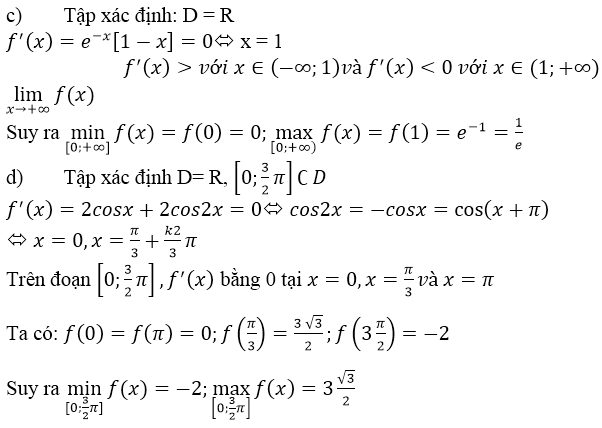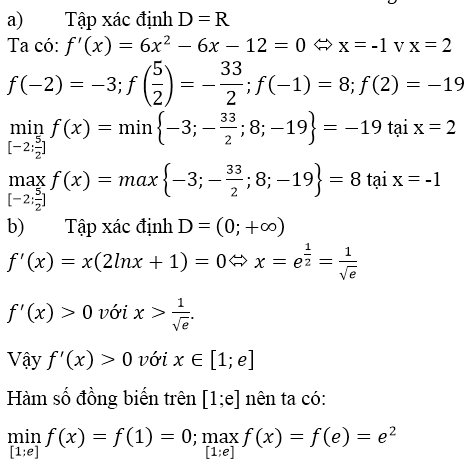Hãy nhập câu hỏi của bạn vào đây, nếu là tài khoản VIP, bạn sẽ được ưu tiên trả lời.

1/ \(f'\left(x\right)=\frac{3\sqrt{x^2+1}-\frac{x\left(3x+1\right)}{\sqrt{x^2+1}}}{x^2+1}=\frac{3\left(x^2+1\right)-3x^2-x}{\left(x^2+1\right)\sqrt{x^2+1}}=\frac{3-x}{\left(x^2+1\right)\sqrt{x^2+1}}\)
Hàm số đồng biến trên \(\left(-\infty;3\right)\) nghịch biến trên \(\left(3;+\infty\right)\)
\(\Rightarrow f\left(x\right)\) đạt GTLN tại \(x=3\)
\(f\left(x\right)_{max}=f\left(3\right)=\frac{10}{\sqrt{10}}=\sqrt{10}\)
2/ \(y'=\frac{\sqrt{x^2+2}-\frac{\left(x-1\right)x}{\sqrt{x^2+2}}}{x^2+2}=\frac{x^2+2-x^2+x}{\left(x^2+2\right)\sqrt{x^2+2}}=\frac{x+2}{\left(x^2+2\right)\sqrt{x^2+2}}\)
\(f'\left(x\right)=0\Rightarrow x=-2\in\left[-3;0\right]\)
\(y\left(-3\right)=-\frac{4\sqrt{11}}{11}\) ; \(y\left(-2\right)=-\frac{\sqrt{6}}{2}\) ; \(y\left(0\right)=-\frac{\sqrt{2}}{2}\)
\(\Rightarrow\left\{{}\begin{matrix}M=-\frac{\sqrt{2}}{2}\\N=-\frac{\sqrt{6}}{2}\end{matrix}\right.\) \(\Rightarrow MN=\frac{\sqrt{12}}{4}=\frac{\sqrt{3}}{2}\)
Tất cả các đáp án đều sai
3/ \(\left\{{}\begin{matrix}\left|x-3\right|\ge0\\\sqrt{x+1}>0\end{matrix}\right.\) \(\Rightarrow f\left(x\right)\ge0\) \(\forall x\Rightarrow N=0\) khi \(x=3\)
- Với \(0\le x< 3\Rightarrow f\left(x\right)=\left(3-x\right)\sqrt{x+1}\)
\(\Rightarrow f'\left(x\right)=-\sqrt{x+1}+\frac{\left(3-x\right)}{2\sqrt{x+1}}=\frac{-2\left(x+1\right)+3-x}{2\sqrt{x+1}}=\frac{-3x+1}{2\sqrt{x+1}}\)
\(f'\left(x\right)=0\Rightarrow x=\frac{1}{3}\)
- Với \(3< x\le4\Rightarrow f\left(x\right)=\left(x-3\right)\sqrt{x+1}\)
\(\Rightarrow f'\left(x\right)=\sqrt{x+1}+\frac{x-3}{2\sqrt{x+1}}=\frac{2\left(x+1\right)+x-3}{2\sqrt{x+1}}=\frac{3x-1}{2\sqrt{x+1}}>0\) \(\forall x>3\)
Ta có: \(f\left(0\right)=3\) ; \(f\left(\frac{1}{3}\right)=\frac{16\sqrt{3}}{9}\) ; \(f\left(4\right)=\sqrt{5}\)
\(\Rightarrow M=\frac{16\sqrt{3}}{9}\Rightarrow M+2N=\frac{16\sqrt{3}}{9}\)
Câu 2 hình như câu B mà người ta nói đạt GTLN . GTNN tại M , N nên là 0 x -2 =0

\(g\left(x\right)=x^4-4x^3+4x^2+a\)
\(g'\left(x\right)=4x^3-12x^2+8x=0\Leftrightarrow4x\left(x^2-3x+2\right)\Rightarrow\left[{}\begin{matrix}x=0\\x=1\\x=2\end{matrix}\right.\)
\(f\left(0\right)=f\left(2\right)=\left|a\right|\) ; \(f\left(1\right)=\left|a+1\right|\)
TH1: \(\left\{{}\begin{matrix}M=\left|a\right|\\m=\left|a+1\right|\end{matrix}\right.\) \(\Rightarrow\left\{{}\begin{matrix}\left|a\right|\ge\left|a+1\right|\\\left|a\right|\le2\left|a+1\right|\end{matrix}\right.\) \(\Rightarrow\left[{}\begin{matrix}-\dfrac{2}{3}\le a\le-\dfrac{1}{2}\\a\le-2\end{matrix}\right.\) \(\Rightarrow a=\left\{-3;-2\right\}\)
TH2: \(\left\{{}\begin{matrix}M=\left|a+1\right|\\m=\left|a\right|\end{matrix}\right.\) \(\Rightarrow\left\{{}\begin{matrix}\left|a+1\right|\ge\left|a\right|\\\left|a+1\right|\le2\left|a\right|\end{matrix}\right.\) \(\Rightarrow\left\{{}\begin{matrix}-\dfrac{1}{2}\le a\le-\dfrac{1}{3}\\a\ge1\end{matrix}\right.\) \(\Rightarrow a=\left\{1;2;3\right\}\)

3.
\(y'=-3x^2-6x=0\Rightarrow\left[{}\begin{matrix}x=-2\\x=0\end{matrix}\right.\)
\(y\left(-1\right)=m-2\) ; \(y\left(1\right)=m-4\)
\(\Rightarrow y_{min}=y\left(1\right)=m-4\)
\(\Rightarrow m-4=0\Rightarrow m=4\)
4.
Hàm đã cho bậc nhất trên bậc nhất nên đơn điệu trên mọi khoảng xác định
\(\Rightarrow y_{min}+y_{max}=y\left(1\right)+y\left(2\right)=\frac{m+1}{2}+\frac{m+2}{3}=8\)
\(\Rightarrow m=\frac{41}{5}\)
Đáp án B
1.
\(y'=\frac{1}{\left(sinx+1\right)^2}.cosx>0\Rightarrow y\) đồng biến
\(m=y_{min}=y\left(0\right)=2\)
\(M=y_{max}=y\left(1\right)=\frac{5}{2}\)
\(\Rightarrow M^2+m^2=\frac{41}{4}\)
2.
Hàm xác định trên \(\left[-2;2\right]\)
\(y'=1-\frac{x}{\sqrt{4-x^2}}=0\Leftrightarrow x=\sqrt{2}\)
\(y\left(-2\right)=-2\) ; \(y\left(\sqrt{2}\right)=2\sqrt{2}\) ; \(y\left(2\right)=2\)
\(\Rightarrow N=-2;M=2\sqrt{2}\)
\(\Rightarrow M+2N=2\sqrt{2}-4\)

1.
Hàm trùng phương có đúng 1 cực trị khi:
TH1: \(a=m=0\)
TH2: \(ab=-m>0\Leftrightarrow m< 0\)
\(\Rightarrow m\le0\)
Đáp án B
2.
\(y'=3\left(x^2+2mx+m^2-1\right)=3\left(x+m+1\right)\left(x+m-1\right)\)
\(y'=0\Rightarrow\left[{}\begin{matrix}x=-m+1\\x=-m-1\end{matrix}\right.\)
Hàm số có 2 cực trị nằm về 2 phía trục hoành
\(\Leftrightarrow y'\left(-m+1\right).y'\left(-m-1\right)< 0\)
\(\Leftrightarrow\left(3m-2\right)\left(3m+2\right)< 0\Rightarrow-\frac{2}{3}< m< \frac{2}{3}\)
\(\Rightarrow a+2b=-\frac{2}{3}+2.\frac{2}{3}=\frac{2}{3}\)

a) f(x) = 2x3 – 3x2 – 12x + 1 ⇒ f’(x) = 6x2 – 6x – 12
f’(x) = 0 ⇔ x ∈ {-1, 2}
So sánh các giá trị:
f(x) = -3; f(-1) = 8;
f(2) = -19, f(52)=−332f(52)=−332
Suy ra:
maxx∈[−2,52]f(x)=f(−1)=8minx∈[−2,52]f(x)=f(2)=−19maxx∈[−2,52]f(x)=f(−1)=8minx∈[−2,52]f(x)=f(2)=−19
b) f(x) = x2 lnx ⇒ f’(x)= 2xlnx + x > 0, ∀ x ∈ [1, e] nên f(x) đồng biến.
Do đó:
maxx∈[1,e]f(x)=f(e)=e2minx∈[1,e]f(x)=f(1)=0maxx∈[1,e]f(x)=f(e)=e2minx∈[1,e]f(x)=f(1)=0
c) f(x) = f(x) = xe-x ⇒ f’(x)= e-x – xe-x = (1 – x)e-x nên:
f’(x) = 0 ⇔ x = 1, f’(x) > 0, ∀x ∈ (0, 1) và f’(x) < 0, ∀x ∈ (1, +∞)
nên:
maxx∈[0,+∞)f(x)=f(1)=1emaxx∈[0,+∞)f(x)=f(1)=1e
Ngoài ra f(x) = xe-x > 0, ∀ x ∈ (0, +∞) và f(0) = 0 suy ra
maxx∈[0,+∞)f(x)=f(0)=0maxx∈[0,+∞)f(x)=f(0)=0
d) f(x) = 2sinx + sin2x ⇒ f’(x)= 2cosx + 2cos2x
f’(x) = 0 ⇔ cos 2x = -cosx ⇔ 2x = ± (π – x) + k2π
⇔ x∈{−π+k2π;π3+k2π3}x∈{−π+k2π;π3+k2π3}
Trong khoảng [0,3π2][0,3π2] , phương trình f’(x) = 0 chỉ có hai nghiệm là x1=π3;x2=πx1=π3;x2=π
So sánh bốn giá trị : f(0) = 0; f(π3)=3√32;f(π)=0;f(3π2)=−2f(π3)=332;f(π)=0;f(3π2)=−2
Suy ra:
maxx∈[0,3π2]f(x)=f(π3)=3√32minx∈[0,3π2]f(x)=f(3π2)=−2

\(f\left(x\right)=\frac{x^2}{2}-4\ln\left(3-x\right)\) trên đoạn \(\left[-2;1\right]\)
Ta có :
\(f'\left(x\right)=x+\frac{4}{3-x}=\frac{-x^2+3x+4}{3-x}=0\Leftrightarrow-x^2+3x+4=0\)
\(\Leftrightarrow\left[\begin{array}{nghiempt}x=-1\in\left[-2;1\right]\\x=4\notin\left[-2;1\right]\end{array}\right.\)
Mà :
\(\begin{cases}f\left(-2\right)=2-4\ln5\\f\left(-1\right)=\frac{1}{2}-8\ln2=\frac{1-16\ln2}{2}\\f\left(1\right)=\frac{1}{2}-4\ln2=\frac{1-8\ln2}{2}\end{cases}\) \(\Rightarrow\begin{cases}Max_{x\in\left[-2;1\right]}f\left(x\right)=\frac{1-8\ln2}{2};x=1\\Min_{x\in\left[-2;1\right]}f\left(x\right)=\frac{1-16\ln2}{2};x=-1\end{cases}\)

5.
\(y'=4x^3-8x=0\Rightarrow\left[{}\begin{matrix}x=0\\x=\sqrt{2}\\x=-\sqrt{2}\left(l\right)\end{matrix}\right.\)
\(y\left(0\right)=-2\) ; \(y\left(\sqrt{2}\right)=-6\) ; \(y\left(\sqrt{3}\right)=-5\)
\(\Rightarrow M=-2\)




Đáp án D
Xét hàm số .
.
Bảng biến thiên
Do nên
nên  suy ra
suy ra  .
.
Suy ra .
.
Nếu thì
thì  ,
, 
Nếu thì
thì  ,
, 
Do đó hoặc
hoặc  , do a nguyên và thuộc đoạn
, do a nguyên và thuộc đoạn  nên
nên  .
.